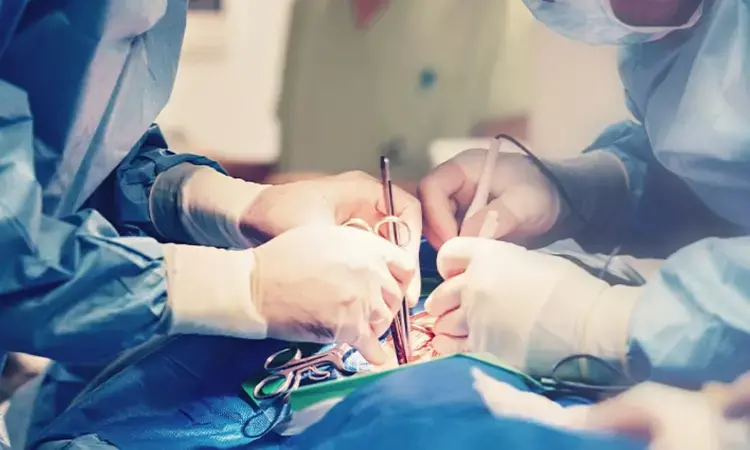- Home
- Medical news & Guidelines
- Anesthesiology
- Cardiology and CTVS
- Critical Care
- Dentistry
- Dermatology
- Diabetes and Endocrinology
- ENT
- Gastroenterology
- Medicine
- Nephrology
- Neurology
- Obstretics-Gynaecology
- Oncology
- Ophthalmology
- Orthopaedics
- Pediatrics-Neonatology
- Psychiatry
- Pulmonology
- Radiology
- Surgery
- Urology
- Laboratory Medicine
- Diet
- Nursing
- Paramedical
- Physiotherapy
- Health news
- Fact Check
- Bone Health Fact Check
- Brain Health Fact Check
- Cancer Related Fact Check
- Child Care Fact Check
- Dental and oral health fact check
- Diabetes and metabolic health fact check
- Diet and Nutrition Fact Check
- Eye and ENT Care Fact Check
- Fitness fact check
- Gut health fact check
- Heart health fact check
- Kidney health fact check
- Medical education fact check
- Men's health fact check
- Respiratory fact check
- Skin and hair care fact check
- Vaccine and Immunization fact check
- Women's health fact check
- AYUSH
- State News
- Andaman and Nicobar Islands
- Andhra Pradesh
- Arunachal Pradesh
- Assam
- Bihar
- Chandigarh
- Chattisgarh
- Dadra and Nagar Haveli
- Daman and Diu
- Delhi
- Goa
- Gujarat
- Haryana
- Himachal Pradesh
- Jammu & Kashmir
- Jharkhand
- Karnataka
- Kerala
- Ladakh
- Lakshadweep
- Madhya Pradesh
- Maharashtra
- Manipur
- Meghalaya
- Mizoram
- Nagaland
- Odisha
- Puducherry
- Punjab
- Rajasthan
- Sikkim
- Tamil Nadu
- Telangana
- Tripura
- Uttar Pradesh
- Uttrakhand
- West Bengal
- Medical Education
- Industry
Is sacrospinous ligament fixation a safer method for treating pelvic organ prolapse?

China: A new study published in Urology shows that uterosacral ligament suspension (ULS) and sacrospinous ligament fixation (SLF) are both safe and effective surgical treatments for pelvic organ prolapse.
Pelvic organ prolapse (POP) is a gynecological disorder in which the pelvic organs protrude into the vagina as a result of ligament or muscle weakening. POP is classified based on the compartment of descent. Yuanzhuo Chen and colleagues carried out this research to examine the safety and effectiveness of sacrospinous ligament fixation (SSLF) and uterosacral ligament suspension (ULS) for surgical repair of pelvic organ prolapse (POP).
Comparative studies were found in the databases EMBASE, PubMed, Cochrane Library, MEDLINE, Medicine, and clinicaltrials.gov for this study. There were randomized controlled trials, as well as prospective and retrospective cohort studies. Anatomical rate of success (defined as anterior or posterior vaginal wall beyond the hymen), surgical rate of success, recurrence, and total complication rate were recorded as primary outcomes, while specific problems rates were obtained as secondary outcomes. Revman was used to examine the data (Version 5.4).
The key findings of this study were as follows:
1. After scanning databases and eliminating duplicate research, 57 publications made it to the screening step.
2. Finally, 9 studies of moderate to high quality (4 randomized controlled trials and 5 retrospective studies) with a total of 4516 people were selected.
3. There was no statistical difference between the two groups in terms of anatomical success, surgical success rate, recurrence rate, or overall complication rate.
4. A subgroup study of different follow-up intervals (1, 2, and 5 years) and stages (Stage 2 and Stage 3-4) revealed similar main outcomes.
In conclusion, sacrospinous ligament fixation appears to have reduced complication rates of vaginal granulation tissue and urethral damage and is rapidly becoming more popular among surgeons due to its quick surgery duration and simplicity. More high-quality research is still needed, particularly on the occurrence of problems.
Reference:
Chen, Y., Peng, L., Zhang, J., Shen, H., & Luo, D. (2022). Sacrospinous Ligament Fixation vs Uterosacral Ligaments Suspension for Pelvic Organ Prolapse: A Systematic Review and Meta-Analysis. In Urology. Elsevier BV. https://doi.org/10.1016/j.urology.2022.04.012
Neuroscience Masters graduate
Jacinthlyn Sylvia, a Neuroscience Master's graduate from Chennai has worked extensively in deciphering the neurobiology of cognition and motor control in aging. She also has spread-out exposure to Neurosurgery from her Bachelor’s. She is currently involved in active Neuro-Oncology research. She is an upcoming neuroscientist with a fiery passion for writing. Her news cover at Medical Dialogues feature recent discoveries and updates from the healthcare and biomedical research fields. She can be reached at editorial@medicaldialogues.in
Dr Kamal Kant Kohli-MBBS, DTCD- a chest specialist with more than 30 years of practice and a flair for writing clinical articles, Dr Kamal Kant Kohli joined Medical Dialogues as a Chief Editor of Medical News. Besides writing articles, as an editor, he proofreads and verifies all the medical content published on Medical Dialogues including those coming from journals, studies,medical conferences,guidelines etc. Email: drkohli@medicaldialogues.in. Contact no. 011-43720751


